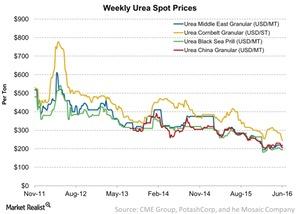Urea Prices: Still a Concern for Nitrogen Fertilizer Stocks
As most global ammonia production is upgrading to urea, ammonia prices may affect urea prices.
June 7 2016, Updated 9:08 a.m. ET

Urea prices
Previously in this series, we discussed ammonia prices last week. As most global ammonia production is upgrading to urea, ammonia prices may affect urea prices. Overall, urea prices for the week ended June 3 remained largely unchanged except for the Corn Belt.
Granular urea prices
Granular urea prices in the Corn Belt fell to $222 per metric ton FOB (free on board) from $231 per metric ton—a decline of 3.9% from a week earlier. The decline continues to indicate weakness in the region. Year-over-year, Corn Belt prices are down 32%.
Granular urea prices in China, on the other hand, have remained unchanged at $208 per metric ton compared to the previous week. Urea in China fell 23% from $270 per metric ton in the same week last year.
In the Middle East, granular urea prices remained unchanged at $218 per metric ton. Urea prices have fallen 21% in the Middle East from $275 per metric ton in the same week in 2015.
Prilled urea prices
At $195 per metric ton, prilled urea prices from the Black Sea region were flat week-over-week. Prilled urea prices from this region fell 25% year-over-year.
The subdued urea price environment remains a challenge for nitrogen fertilizer producers such as CF Industries (CF), CVR Partners (UAN), and Agrium (AGU). Falling prices also affect the iShares US Basic Materials ETF (IYM). IYM invests ~48% of its holdings in chemical companies and 9% in Monsanto (MON). In the next part of this series, we’ll look at natural gas, a key input cost for nitrogen fertilizers. According to PotashCorp, natural gas accounts for 70%–85% of ammonia production costs.
